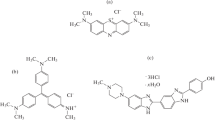Abstract
Through the fluorescence and ultravioletvisible spectrophotometry we have studied the action of cefoperazone sodium and worfloxacin, two kinds of medicine with albumin, and examined the equal efficiency quality of fluorescence enhancement and fluorescence quenching equation. The result shows the equal efficiency of calculating dissociation constant. In this article, we obtain the dissociation constants of the action of the two kinds of medicine with bovine serum albumin, energy-transfer efficiency, the distance of donor-acceptor and quenching constants. The above shows that the action is not caused by dynamic collision but by the binding of medicine and albumin. This article specially points out that the [Mt]/[Pt], which is the ratio of the maximum mol concentration of the quenching agent (medicine) to fluorescent (albumin) mol concentration when the quenching ends, is very important because it is the maximum binding number of quenching agent molecule to a fluorescent molecule. There is no more quenching after adding more quenching agent beyond this quantity to fluorescent solution. This quantity is determined directly and strictly by experiment, so is also of important significance when discussing quenching efficiency and binding situation of donor-acceptor.
Similar content being viewed by others
References
Yang, P., Yang, M. M., Yang, B. S., The fluorescence enhancement and the action between donr and acceptor, Chinese Journal of Chemistry, 1996, 14(2): 9–113.
Yang, M. M., Yang, P., Zhang, L. W., Study on interaction of caffeic acid series medicine and alburmin by fluorescence method, Chinese Science Bulletin, 1994, 39(9): 734–739.
Zhu, K., Tong, S. Y., Study of interaction between fluorandiol and protein, Chemical Journal of Chinese Universities, 1996, 17(4): 539–542.
Dong, R. A., Zhang, F. S., Song, X. Q., Study of binding reaction of water-Soluble ZnPcS4 with BSA, Chinese Science Bulletin, 1996, 41(11): 1001–1005.
Zhu K., Tong, S. Y., A study on the reaction between protein and acidum pipemidicum/norfloxacium, Acta Chimica Sinica, 1997, 55(4): 405.
Lu, J. X., Zhang, G. Z., Zhao, P. et al., Interaction of Adriacin with BSA and the effect of together ions for reaction, Acta Chimica Sinica, 1997, 55(9): 915
Yu, T. Z., Tao, Z. Y., Fluorecence study on the interaction of salicylic acid and human serum albumin, Spectroscopy and Spectral Analysis, 1999, 19(3): 453–455.
Li, L. Z., Zhang, W. M., Li, R. C. et al., Interactions of cisplatin and transplatin with membrane glycoproteins of erythrocyte, J. Inorg. Chem., 1995, 11(3): 267–271.
Yang, M. M., Yang, P., Xi, X. L., Bonding between fluorescence dyes and proteins, Chinese Science Bulletin, 1997, 42(17): 1429–1432.
Xi, X. L., Yang, M. M., Han, X. J. et al., Study on the interaction mechanism of fluorescence dyes with DNA, Chinese Journal of Inorganic Chemistry, 2001, 17(6): 781–786.
Yang, P., Yang, B. S., Ci, Y. X. et al., Application of fluorescence probe of lanthanides in biology and medicine, Basic Medical Sciences and Cilinics, 1995, 15(4): 255–260.
Yang, P., Ma, G. B., Study on ternary complex of rare earth gadolinium (III) with human serum albumin and citrate, Chinese Science Bulletin, 1990, 35(10): 821–824.
Yang, P., Ren, R., Yang, B.S., Study of interaction of some metal ions with DNA using Tb(III) probe, Chemical Research and Application, 1994, 6(1): 22–26.
Yang, P., Yang, B. S., Wang, J. L., The binding of lanthanides to human serum g-globulin, Chinese Science Bulletin, 1989, 34(9): 747–750.
Guo, M. L., Yang, P., Yang, B. S., Ethidium bromide as a fluorescent probe for the interaction mode between titanocene and DNA, Chinese Science Bulletin, 1996, 41(13): 1098–1103.
Ma, G. B., Yang, P., Zhai, J., Studies on the interaction of multimolecular systems by fluorescent—Probe of terbium ion, Chinese Science Bulletin, 1994, 39(1): 37–40.
Yang, P., Gao, F., Principle of Bioinorganic Chemistry (in Chinese), Beijing: Science Press, 2002, 322–342; 489–494.
Yang, P., Introduction to Bioinorganic Chemistry (in Chinese), Xi’an: Xi’an Jiaotong University Press, 1991, 145–166.
Author information
Authors and Affiliations
Corresponding author
About this article
Cite this article
Yang, M., Xi, X. & Yang, P. The equal-efficiency-proving of fluorescence quenching and enhancement equation. Chin. Sci. Bull. 50, 2571–2574 (2005). https://doi.org/10.1007/BF03183652
Received:
Accepted:
Issue Date:
DOI: https://doi.org/10.1007/BF03183652




